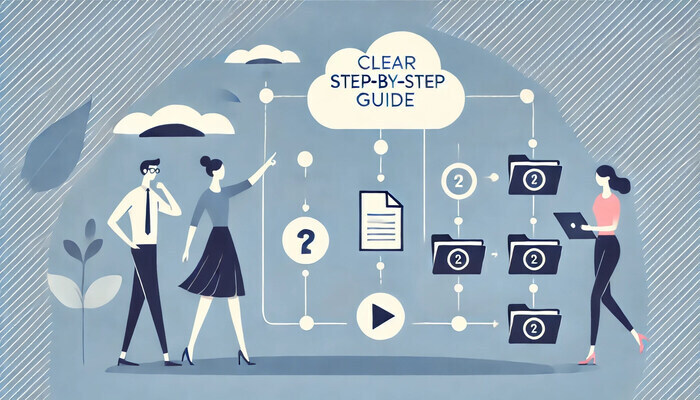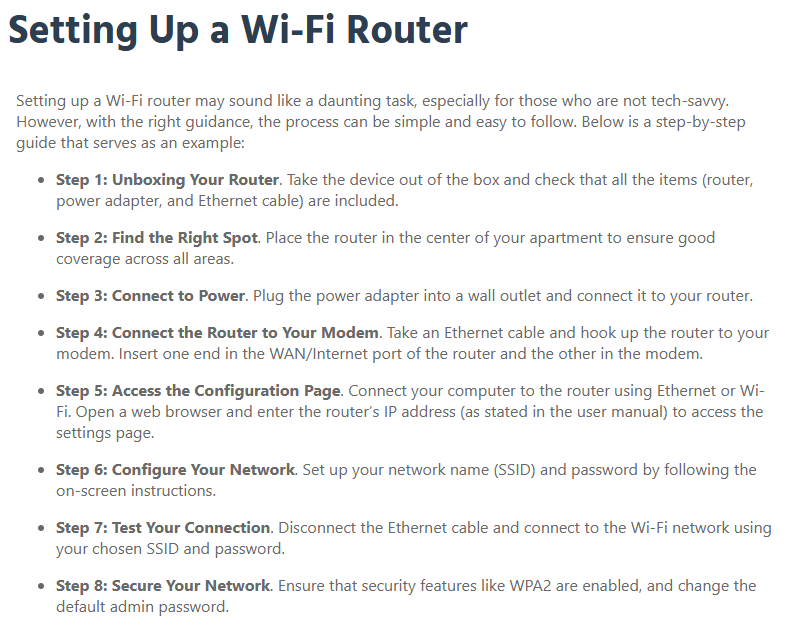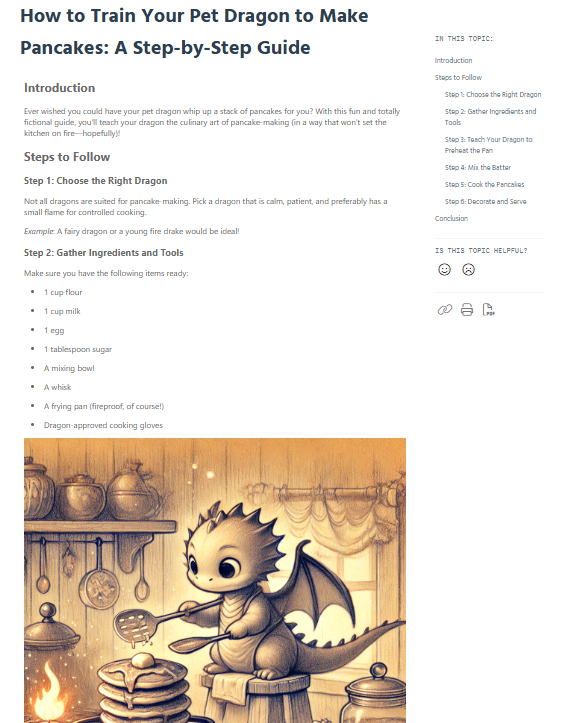
Effective communication relies on clarity and simplicity. Whether you’re showcasing a new software application, teaching a technical skill, or outlining a complex process, a well-structured step-by-step guide can greatly improve comprehension.
For example, consider the launch of a popular IT product—a cloud storage service—that was released without a comprehensive user manual. Many users became overwhelmed by the interface and features, leading to confusion and frustration. As a result, the company faced a surge of customer support inquiries and negative reviews, highlighting the critical need for clear instructional content. By following the guidelines presented in this article, you’ll be able to avoid similar pitfalls and create a guide that empowers users to navigate your product with confidence.
Why Use a Step-by-Step Guide?
A step-by-step guide simplifies complex information by breaking it down into manageable parts. This format is beneficial because it ensures the following:
- Promotes Clarity: Minimizes ambiguity in instructions.
- Provides Visuals for Understanding: Allows readers to follow along at their own pace, reducing frustration.
- Supports Learning: Helps with retention by breaking down information into digestible pieces.
A step-by-step guide is a valuable tool that simplifies even the most complex tasks and boosts efficiency. By breaking down processes into manageable steps, it helps users navigate challenges with confidence. Whether it’s learning new skills, completing projects, or achieving personal goals, a structured approach not only makes the journey smoother but also more successful. These guides empower individuals to tackle even the most daunting tasks with clarity and ease.
Steps to Create Your Guide
Writing a step-by-step guide requires several structured steps. Here is a set of guidelines that one should follow when creating an effective and informative guide:
- Identify Your Topic. Start by choosing a particular subject your guide will be about. Make sure it can be divided into clear, actionable steps.
Example: “How to Set Up a Virtual Private Network (VPN) on Windows”
- Know Your Audience. Know who your readers are. Adapt your guide according to their level of expertise and familiarity with the topic.
Example: If your audience comprises beginners, the text should define technical terms and the software which they are used to dealing with.
- Break Down the Process. Divide the activity into simple, manageable steps. Each step should logically follow the previous one.
Example:
- Download a reliable VPN client from an official site.
- Install the software by following the on-screen prompts.
- Open the VPN application and sign in with your credentials.
- Select a server location from the list.
- Click the “Connect” button to establish a secure connection.
- Verify your connection by checking your IP address on a website like whatismyip.com.
- Step-by-Step Instructions. When writing your instructions, be clear and direct. Use active voice and simple language for better understanding.
Example: Instead of saying “The connection should be established,” say “Click ‘Connect’ to establish the VPN connection.”
- Incorporate Visuals. Including images, screenshots, or videos will greatly improve comprehension and make the guide more engaging.
Example: Add screenshots for each step to show the installation process, the application interface, and connection status.
- Review and Test. After drafting your guide, review it carefully. Ideally, ask someone unfamiliar with VPNs to follow your guide and highlight any sections that are unclear.
- Finalize and Publish. Once you’ve refined your guide, select an appropriate platform for publication. This could be a blog, a PDF document, or an online help center, depending on your intended audience and distribution method.
How-to Guide Example
Here is an example of a step-by-step guide for setting up a Wi-Fi router:

This step-by-step guide for setting up a Wi-Fi router offers several benefits. First, it simplifies the process, making it accessible even for those who may not be tech-savvy. By breaking down the setup into manageable steps, users can follow along easily without feeling overwhelmed.
Additionally, this template serves as a reliable reference, ensuring that important configurations are not overlooked, which can lead to a more stable and secure internet connection.
Finally, having a clear guide boosts user confidence, empowering them to troubleshoot issues and assist others in the future. Overall, this template not only streamlines the setup process but also enhances users’ understanding and control over their home network.
Step-by-Step Guide Template
A clear and concise guide can make all the difference when trying to complete new tasks or learn new skills. This step-by-step guide template is designed to provide readers with a structured way of understanding and effectively accomplishing a particular task. Whether it’s setting up a new device, mastering a software application, or learning a new recipe, this guide will simplify the process and improve comprehension.
Title: [Guide Topic]
Introduction: Briefly introduce the topic and explain its significance.
Audience: Identify who the guide is intended for.
Steps to Follow:
Step 1: [Description]
Further details, visuals, or examples if necessary.
Step 2: [Description]
Further details, visuals, or examples if necessary.
Step 3: [Description]
Further details, visuals, or examples if necessary.
Continue as Necessary
Conclusion: Summarize the key takeaways from your guide and let your readers know where to reach out if they have more questions or need clarification.
This how-to guide template will help simplify complex topics, making them more manageable. The step-by-step process will enable readers to better understand and successfully perform the task.

Automatic Step-by-Step Guide Generators
Automatic step-by-step guide generators are innovative tools that streamline the creation of content using advanced algorithms and artificial intelligence. They transform complex processes into easy-to-follow guides with minimal manual input.
The features of step-by-step guide generators are the following:
- Template-Based Creation: Users can select from various templates for different types of guides, such as how-tos and troubleshooting.
- NLP: This helps process user input into clear instructions while maintaining user-friendly language.
- Visual Integration: Automatic inclusion of images, screenshots, or videos.
- Interactive Elements: Some generators offer interactive features, such as collapsible sections or embedded quizzes.
- Customization Options: Users can tailor the content to fit their brand voice and audience needs.
Here are four examples of automatic step-by-step guide generator apps:
- Scribe. This tool automatically captures steps during a process and generates detailed guides.
- Process Street. Offers templates for creating workflows and checklists.
- GuideCX. Focuses on customer onboarding guides with collaborative features.
- Greenshot. This is an open-source screenshot tool with the capability to capture images from the screen fast, add text, shapes, and highlights. It is lightweight, integrated into a number of applications, and well-suited for simple visual guides and documentation. While this last tool is not an automatic step-by-step guide generator, it is highly effective for creating instructional content manually by enhancing visual clarity and interactivity.
Automatic step-by-step guide generators streamline the creation of instructional content, making it easier to produce clear and engaging guides. Their efficiency and user-friendly features enhance the quality and accessibility of resources, benefiting both creators and users.
Creating a Step-by-Step Guide with ClickHelp
Writing a comprehensive and user-friendly step-by-step guide is crucial for conveying information in a way that users can easily follow. ClickHelp, a powerful documentation tool, simplifies the process of writing guides by making the creation, management, and publication of content easier. Here’s how to use ClickHelp to craft an effective step-by-step guide:
- Choose Your Topic Wisely. Define a relevant and valuable topic for your audience. Consider the challenges your users might face and how your guide can help solve them. A well-defined topic ensures an effective and focused guide.
- Outline Your Steps. Create a preliminary outline of the steps your guide will cover. This helps organize your thoughts and ensures you don’t overlook critical details. Each step should be clear, concise, and logically lead the user through the process.
- Take Advantage of ClickHelp’s Features. ClickHelp has a set of features that will make your guide look and feel great:
- Rich Text Editor: Format your content using headings, lists, and styling to improve readability.
- Images and Videos: Embed visuals like screenshots, diagrams, or videos to make instructions clearer and easier to follow.
- Interactive Elements: Add features such as collapsible sections or tooltips to provide extra information without cluttering the page.
- Write Clear and Concise Instructions. Use plain language and avoid unnecessary jargon. Each step should be actionable and precise. For example:
- Step 1: Open the application by double-clicking the desktop icon.
- Step 2: Click the ‘Settings’ menu at the top right corner.
- Add Context Where Needed. Provide brief explanations or tips to help users understand why they’re performing certain actions. This not only improves comprehension but also enhances engagement.
- Review and Edit. Carefully review your guide for clarity, accuracy, and grammatical correctness. Ensure all links and visuals function correctly, and confirm the steps flow logically. Consider having someone unfamiliar with the topic test your guide to identify any gaps.
- Publish and Gather Feedback. Use ClickHelp’s publishing options to share your guide. After publication, solicit reader feedback to identify areas for improvement and keep your guide relevant and effective.
- Update Regularly. Technology and processes evolve over time. Regularly review and update your guide to ensure it remains accurate and useful to your audience.
By following these steps and taking advantage of ClickHelp’s robust features, you can create well-structured, informative, and user-friendly step-by-step guides that empower your audience to confidently complete their tasks.
Below is an example of a step-by-step guide made with ClickHelp:

Conclusion
By following these guidelines and utilizing the provided template, you can create a clear, informative, and effective step-by-step guide. This approach will support your audience in learning new tasks or skills while helping them achieve their goals. Remember, clarity is essential—ensure each step is straightforward, actionable, and easy to comprehend.
Good luck with your technical writing!
Author, host and deliver documentation across platforms and devices

